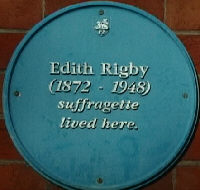Another remarkable resident of Winckley Square was a lady - born Edith Rayner, at number 1 Pole Street, she was the sister of Dr. Arthur Rayner who founded the X-Ray Department at Preston Royal Infirmary. Just before her twenty-first birthday in 1893, she married Dr. Charles Rigby and they set up house at number 28 Winckley Square, next door to . Edith had always been unusual. She identified with the poor cotton workers and mill girls she had known as a child, rather than with the wealthy, middle-class residents of Winckley Square.
Mrs. Rigby was strikingly beautiful; tall, with wheat-gold hair and blue eyes. She wore extraordinary dresses, like blue sacking, with heavy, amber-coloured beads on chains. Though she was clearly authoritative, she never raised her voice, but gave an overwhelming impression of gentleness. Always concerned for the under-dog, Mrs. Rigby founded, in 1899, a night-school and recreation club for working girls in St. Peter's school in Brook Street.
She inquired, much to the annoyance of her Winckley Square neighbours, into the working conditions of maids who, in her own house, were treated as equals. One family, who lived a few doors away, were so incensed by this that they called on her one evening and told her plainly that if she couldn't alter her, ways she had better leave the neighbourhood.
Her courage and idealism never wavered, for she then became involved in the Suffrage Movement and, in 1907, formed a Preston branch of the Women's Social and Political Union with herself as Secretary. All the organisation of this branch and its early meetings were held at number 28 Winckley Square, and when important members of the movement visited the town, that is where they stayed. Many dinner parties were held there with the ladies wearing their ceremonial long white dresses and the sashes of white-corded ribbon edged with purple and green.
Mrs. Rigby and her friends were part of the militant branch of the Suffragettes, and she was blamed for the tarring of Lord Derby's statue in Miller Park. Although this was her idea and she arranged it all she did not actually commit the awful deed. She did, however, burn down Lord Leverhulme's wooden bungalow on Rivington Pike and throw a bomb into the Liverpool Cotton Exchange. She was imprisoned many times for these offences, and suffered the terrible forcible feeding.
On one occasion, when the police called at number 28 Winckley Square to re-arrest her under the 'Cat and Mouse' Act, she made her escape to Ireland from the rear of the house, wearing workman's clothes and riding a bicycle!
 |
Edith Rigby was an extremely brave woman, both physically and morally, and you can read her story in the book 'My Aunt Edith', written by her niece, the poet, Phoebe Hesketh, to whom I am indebted for all the foregoing. |
Here, also is a poem by Phoebe Hesketh, which is a fitting end to my brief account of Edith Rigby. It is entitled and as you read it, remember that Phoebe Hesketh was the daughter of Dr. Arthur Rayner and their home was number 9 Ribblesdale Place.
. A peom about Edith Rigby by the Preston poet, Christine Billington.